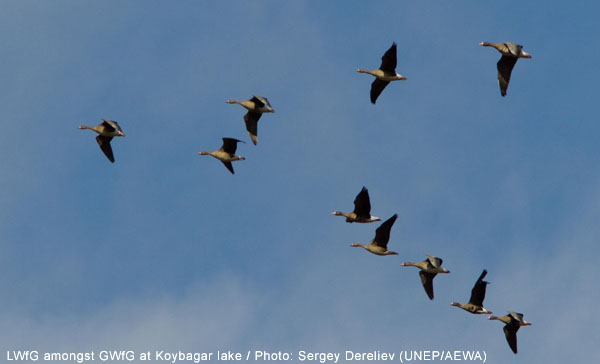Work starts on National Action Plan for the Lesser White-fronted Goose in Kazakhstan

Bonn, 19 October 2010 - At a
two day national workshop on the Lesser White-fronted Goose
(Anser erythropus)
in Kostanay in northern Kazakhstan last week (12 – 14
October 2010) participants agreed on a basic structure
for a National Action Plan for the Conservation of the
Lesser White-fronted Goose – including main threats
and activities - for Kazakhstan.
The meeting was chaired by the Kazakhstan national representative
to the AEWA International Lesser White-fronted Goose Working
Group, Mr. Bakytbek Duisekeyev from the Committee of Forestry
and Hunting and was facilitated by AEWA Technical Officer
Mr. Sergey Dereliev. The meeting was also attended by Mr.
Tomas Aarvak from the Norwegian Ornithological Society
who took part in the meeting in his capacity as international
Lesser White-fronted Goose expert and Ms. Nina Mikander,
the Coordinator for the Lesser White-fronted Goose based
at the UNEP/AEWA Secretariat.
Kazakhstan is one of the most important range states for
the globally threatened LWfG as the entire Western main
population is thought to stage in northern Kazakhstan in
the Kostanay region during spring and autumn migration.
In addition, a varying number of individuals from the Fennoscandian
population migrate through the area in autumn on the way
to southern Europe. The national conservation work in Kazakhstan
will hopefully serve as a positive example for other LWfG
range states in the process of starting national conservation
activities for the species.
 |
 |
 |
The meeting commenced with the decision
to form a National Working Group for the species to guide
the drafting of the Action Plan as well as to coordinate
implementation after its adoption. The Working Group will
include government officials, LWfG experts, representatives
from hunters’ organizations and NGOs as well as other
important stakeholders – all of which were represented
at the workshop.
After presentations on the international conservation
status of the species and the implementation of the International
Single Species Action Plan for the LWfG Kazakhstani experts
elaborated on the legal situation and biological status
of the species (the LWfG has been included in Kazakhstan’s
Red Book for endangered species since 2008) as well as
the view of the hunters’ organizations. Russian expert
Ms. Sonia Rozenfeld from the Geese and Swans Study Group
of Eastern Europe and North Asia also gave an update on
the current population estimate based on the 2010 autumn
monitoring mission which took place just prior to the workshop.
Mr. Dereliev then led a group discussion
on the main threats to the species in Kazakhstan followed
by an analysis of
the causes. Not surprisingly the threat from hunting was
reaffirmed as the major cause of mortality of LWfG in Kazakhstan.
Hunting LWfG is illegal, and a system of fines and court
proceedings exist - though poachers are seldom caught and
prosecuted. Legal goose hunting was also deemed a
problem, as many LWfG are killed as a result of incidental
shooting.
In general it was concluded that the hunting culture – at
least concerning waterfowl – is quite low in Kazakhstan.
Hunting skills, in particular with regard to species recognition,
need to be improved. Disturbance through hunting on other
species is also severe, especially during spring migration
when the duck hunting season can coincide with the staging
of Lesser White-fronted Geese in Kostanay.
On day two of the workshop, the group concentrated on
setting goals and objectives for the action plan based
on the threats identified in the problem analysis. The
overall goal in the Kazakh Action Plan for the Western
main population will be identical to that of the International
Action Plan: to raise and maintain the population size
at not less than 25,000 individuals. Activities to decrease
the threat from hunting will include developing a flexible
system to close hunting in key sites during spring and
autumn migration when LWfG are present in large numbers
and increasing the control of game husbandries where the
hunting takes place.
The national action plan will be drafted
by Dr. Sergey Yerokhov from the Kazakhstan Agency for Applied
Ecology
and Dr. Sergey Sklyarenko from the Association on the
Conservation of Biodiversity of Kazakhstan (ACBK) on the
basis of the
objectives, indicators and activities identified during
the workshop. The draft will then be submitted to the national
working group for comments and further to the Committee
for Forestry and Hunting for approval.
 |
 |
 |
The workshop was rounded off on day three by an optional
excursion to the lakes Koybagar and Tiuntiugur east of
the city of Kostanay.
The LWfG National Action Planning workshop was funded
by the German Federal Ministry for the Environment, Nature
Conservation and Nuclear Safety and the Finnish Ministry
of the Environment. The monitoring mission carried out
the week prior to the workshop was funded by the Norwegian
Directorate for Nature Management. Both monitoring mission
and the meeting were organized by ACBK, the Kazakhstan
Agency for Applied Ecology and the UNEP/AEWA Secretariat.
For more information please see the International Single
Species Action Plan:
-
- ACBK
article (available in Russian only)
or please contact:
Ms. Nina Mikander,
Coordinator for the Lesser White-fronted Goose
Last updated on 16 June 2014


